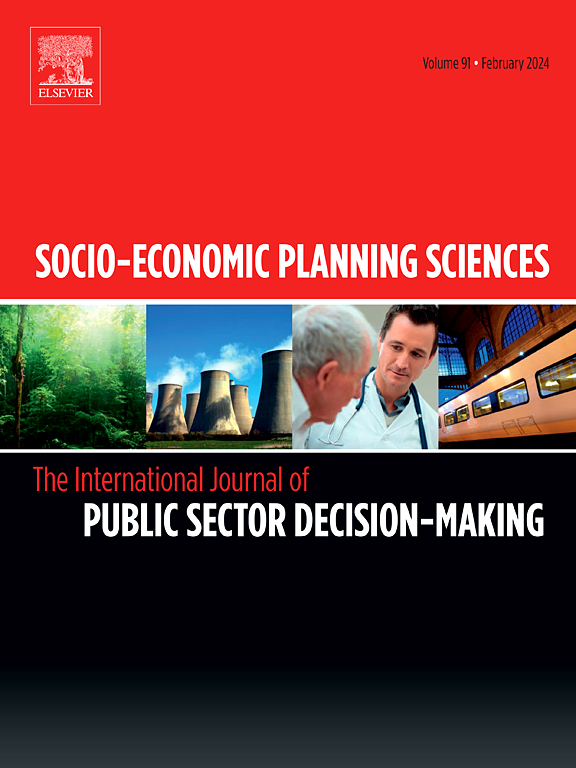提高生态饲料工厂生产效率的经济和环境效益:以日本为例
IF 5.4
2区 经济学
Q1 ECONOMICS
引用次数: 0
摘要
本研究通过数据包络分析(DEA)对日本45家生态饲料工厂的生产效率进行了分析,其中28家采用干法,11家采用液体法,6家采用发酵法。投入包括每年的食物浪费和维护费用,而产出是每年的生态饲料生产。结果表明,干法、液体法和发酵法的平均生产效率得分分别为0.436、0.491和0.469。提高效率可显著提高生态饲料产量。低效的主要来源被确定为纯技术效率(PTE),这突出了工厂之间生产技术的差异。通过改善低效率,销售增长潜力(SIP),即潜在的年度经济节约,估计可达到40亿日元,同时温室气体排放可减少约35,000吨二氧化碳。对于规模效率低下(SE)的工厂,特别是那些规模回报递增(IRS)的工厂,建议扩大生产规模。提出了政策措施,包括将食品相关产业与生态饲料工厂联系起来,以促进这一点。此外,确定效率低下设施的参考工厂,以加强PTE。为了支持这一点,政府应允许工厂管理人员访问参考工厂,并通过要求食品公司更好地分类废物,改善废物管理系统,特别是干法。这些措施旨在改善经济和环境结果。本文章由计算机程序翻译,如有差异,请以英文原文为准。
Economic and environmental benefits of improving production efficiency in eco-feed plants: A case study from Japan
This study analyzed the production efficiency of 45 eco-feed plants in Japan—28 using the dry method, 11 with the liquid method, and six using the fermentation method—through data envelopment analysis (DEA). Inputs included annual food waste and maintenance costs, while the output was annual eco-feed production. The results revealed average production efficiency scores of 0.436 (dry), 0.491 (liquid), and 0.469 (fermentation). Improving efficiency could significantly boost eco-feed production. The primary source of inefficiency was identified as pure technical efficiency (PTE), which highlighted disparities in production technologies among plants. By improving inefficiencies, the sales increase potential (SIP), which refers to the potential annual economic savings were estimated to be 4 billion JPY, while greenhouse gas emissions could be reduced by approximately 35,000 t-CO2. Scaling up production was recommended for plants with scale inefficiencies (SE)—particularly those under increasing returns to scale (IRS). Policy measures, including linking food-related industries to eco-feed plants, were proposed to facilitate this. Additionally, identifying reference plants for inefficient facilities was emphasized to enhance PTE. To support this, the government should enable plant managers to visit reference plants and improve waste management systems—particularly for the dry method—by requiring food companies to better sort waste. These measures aim to improve both economic and environmental outcomes.
求助全文
通过发布文献求助,成功后即可免费获取论文全文。
去求助
来源期刊

Socio-economic Planning Sciences
OPERATIONS RESEARCH & MANAGEMENT SCIENCE-
CiteScore
9.40
自引率
13.10%
发文量
294
审稿时长
58 days
期刊介绍:
Studies directed toward the more effective utilization of existing resources, e.g. mathematical programming models of health care delivery systems with relevance to more effective program design; systems analysis of fire outbreaks and its relevance to the location of fire stations; statistical analysis of the efficiency of a developing country economy or industry.
Studies relating to the interaction of various segments of society and technology, e.g. the effects of government health policies on the utilization and design of hospital facilities; the relationship between housing density and the demands on public transportation or other service facilities: patterns and implications of urban development and air or water pollution.
Studies devoted to the anticipations of and response to future needs for social, health and other human services, e.g. the relationship between industrial growth and the development of educational resources in affected areas; investigation of future demands for material and child health resources in a developing country; design of effective recycling in an urban setting.
 求助内容:
求助内容: 应助结果提醒方式:
应助结果提醒方式:


